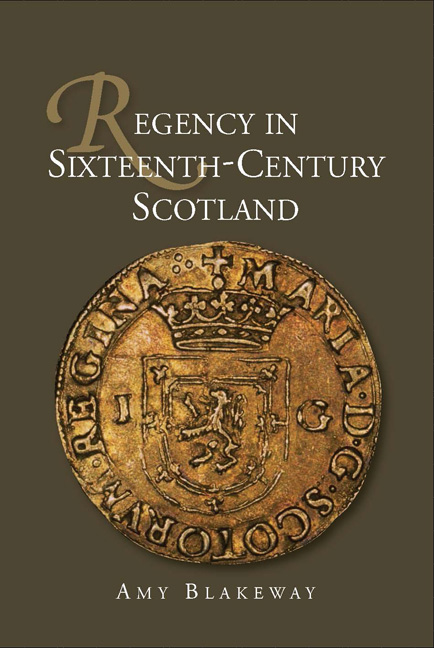Book contents
- Frontmatter
- Dedication
- Contents
- List of Figures and Tables
- Acknowledgements
- List of Abbreviations
- Timeline of Regents and Monarchs
- Introduction
- 1 Concepts of Regency
- 2 Concepts of Regency in Practice
- 3 Regency Finances
- 4 Households and Courts
- 5 Justice and Regency
- 6 Regency Diplomacy
- Conclusion
- Appendix 1 The Treasurer's Accounts
- Appendix 2 The Comptroller's Accounts
- Appendix 3 The Collectors of the Thirds' Accounts
- Appendix 4 Justice Ayres in Sixteenth-Century Scotland
- Bibliography
- Index
4 - Households and Courts
Published online by Cambridge University Press: 05 May 2015
- Frontmatter
- Dedication
- Contents
- List of Figures and Tables
- Acknowledgements
- List of Abbreviations
- Timeline of Regents and Monarchs
- Introduction
- 1 Concepts of Regency
- 2 Concepts of Regency in Practice
- 3 Regency Finances
- 4 Households and Courts
- 5 Justice and Regency
- 6 Regency Diplomacy
- Conclusion
- Appendix 1 The Treasurer's Accounts
- Appendix 2 The Comptroller's Accounts
- Appendix 3 The Collectors of the Thirds' Accounts
- Appendix 4 Justice Ayres in Sixteenth-Century Scotland
- Bibliography
- Index
Summary
On 3 February 1549, Barbara Hamilton, Châtelherault's eldest daughter, married Alexander Gordon, master of Huntly, heir of George Gordon, fourth earl of Huntly. Barbara's appearance on this occasion was, naturally, paramount. Accordingly, a considerable amount was spent to ensure that she looked not only ravishing, but regal, since a ‘rob ryall’ made of purple velvet served as her wedding dress. This was more than simply an expensive item of clothing, as royal robes were traditionally worn by members of the immediate royal family at important political events: Marie de Guise and James v had royal robes made for her coronation in February 1540, and James vI wore a miniature royal robe for his first appearance in parliament in August 1571. Indeed, in 1516 Margaret Tudor had complained that Albany was wearing a royal robe when he had no right to do so. Châtelherault attended the wedding attired in a royal robe of his own, sporting his collar of the French chivalric order of St Michael for international-statesmanlike panache. The implications of this attire would not have been lost on the guests. The choice of entertainment provided Châtelherault with an opportunity to present himself as a man of culture, as a variety of international musicians performed, and a play was especially commissioned from the court writer William Lauder. Châtelherault's Edinburgh townhouse underwent renovations in anticipation of the ceremony, and the interior was decorated with royal tapestries. It is tempting to speculate that the tapestry selected was that depicting the marriage of Aeneas and Lavinia, which may have been used as ‘an allegorical reminder of the political benefits’ which marriages could bring during James v's personal rule. Guests were also given mementos of the occasion, thirty gold rings were fashioned, along with other ‘toyes’, costing £158. Châtelherault evidently understood that largesse was an aspect of princely virtue especially suitable for display at weddings.
- Type
- Chapter
- Information
- Regency in Sixteenth-Century Scotland , pp. 127 - 157Publisher: Boydell & BrewerPrint publication year: 2015



